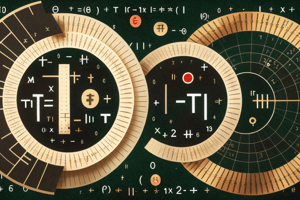Podcast
Questions and Answers
What is the mathematical definition of Pi?
What is the mathematical definition of Pi?
- The ratio of a circle's circumference to its diameter (correct)
- The ratio of a circle's radius to its circumference
- The ratio of a circle's diameter to its area
- The ratio of a circle's circumference to its radius
Who is credited with introducing the modern symbol for Pi, π?
Who is credited with introducing the modern symbol for Pi, π?
- Euclid
- William Chryserinus (correct)
- Pythagoras
- Archimedes
What type of number is Pi?
What type of number is Pi?
- Irrational (correct)
- Whole
- Prime
- Rational
What role does Pi play in geometry?
What role does Pi play in geometry?
When was Pi first observed by ancient civilizations?
When was Pi first observed by ancient civilizations?
To how many decimal places has Pi been calculated, as of 2023?
To how many decimal places has Pi been calculated, as of 2023?
What is the formula for the circumference of a circle in terms of pi?
What is the formula for the circumference of a circle in terms of pi?
Which mathematical concept involves pi in the derivative of the sine function?
Which mathematical concept involves pi in the derivative of the sine function?
In what field is pi used to calculate the volume of a sphere?
In what field is pi used to calculate the volume of a sphere?
What is the integral of the cosine function involving pi equal to?
What is the integral of the cosine function involving pi equal to?
Which area can be calculated using pi in geometry?
Which area can be calculated using pi in geometry?
How does pi appear in art and culture according to the text?
How does pi appear in art and culture according to the text?
Flashcards are hidden until you start studying
Study Notes
The Number Pi in Mathematics
Pi, symbolized as π, is a fundamental mathematical constant that has captivated mathematicians and fascinated laypeople alike for millennia. In this article, we'll delve into the mathematical world of pi, exploring its origins, significance, and the ongoing fascination it inspires.
Origins and Definition
Pi, or the ratio of a circle's circumference to its diameter, was first observed by ancient civilizations around 3000 BC through observations of circles. Its modern symbol, π, is credited to the Greek mathematician William Chryserinus, who used the first letter of the Greek word "periphery" in the 17th century.
The mathematical definition of pi is the ratio of the circumference of a circle to its diameter:
[ \pi = \frac{\text{Circumference}}{\text{Diameter}} ]
Approximations and Decimal Expansion
Pi is an irrational number, meaning it cannot be expressed as a fraction of integers. As a result, its decimal expansion is non-terminating and non-repeating. It has been calculated to trillions of decimal places, with the current record reaching 31.4 trillion digits in 2023.
Pi in Geometry
Pi plays a pivotal role in geometry, particularly in the study of circles and spheres. The most well-known formulas involving pi include:
[ \text{Circle Area} = \pi \cdot r^2 ]
[ \text{Circle Circumference} = 2 \pi \cdot r ]
These formulas find application in various areas, such as calculating the area of a round table or the circumference of a bicycle tire.
Pi in Calculus
Pi also plays a crucial role in calculus, the mathematical study of change and rate of change. In particular, pi is used in the derivative of the sine function:
[ \frac{d}{dx} \sin x = \cos x ]
Pi is also involved in the integral of the cosine function:
[ \int \cos x , dx = \sin x + C ]
Pi in Art and Culture
Pi is not just a mathematical constant; it's also a source of fascination and inspiration in art and culture. For example, the famous mathematician and artist M.C. Escher created a tessellation of circles that demonstrated the beauty of pi's ratio. More recently, various creative projects, such as the Pi Art Challenge, have been launched to celebrate pi.
Pi in Science and Engineering
Pi is not only essential in mathematics but also in science and engineering fields. For example, pi is used to calculate the area of a cylinder or the volume of a sphere, which are important in physics and engineering.
In summary, pi is a fundamental mathematical constant that touches upon various areas of mathematics, including geometry, calculus, and algebra. Its importance cannot be overstated, and the ongoing exploration of pi continues to captivate mathematicians, artists, and those curious about its mysteries.
Studying That Suits You
Use AI to generate personalized quizzes and flashcards to suit your learning preferences.




